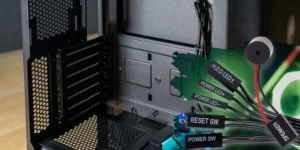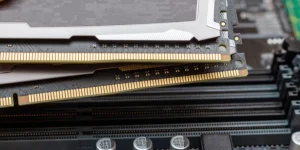CPU FAN and CPU OPT are the names of fan headers for CPU cooling systems. These fan headers are labeled on the motherboard printed circuit board (PCB) with the names CPU_FAN and CPU_OPT respectively. Understanding the CPU_FAN and CPU_OPT fan headers is a critical piece of knowledge when you’re building your PC. This is because these fan headers provide options to connect a cooling system for you PC. Your PC can’t boot or function normally when you have not connected a cooling system to it.
Picture this, you’re in the final steps of building your PC, everything else, including major components have already been attached and you have placed it in the case. The only thing remaining is the fans, and you see two fan header options: CPU_FAN and CPU_OPT.
RELATED: Motherboard Components – A Guide To Building Your Own PC

It gets worse when you look around the motherboard and see other fan header options such as SYS_FAN and CHA_FAN. Worry no more, by the end of this article, you will understand exactly what these are and when to use them.
In this article we’ll cover:
- What Is The Purpose Of The Fan Header?
- What Is A CPU FAN Header?
- What Is A CPU OPT Fan Header?
- Difference Between CPU FAN And CPU OPT Fan Headers
- What Are CHA_FAN And SYS_FAN Headers?
What Is The Purpose Of The Fan Header?
To put it simply, the fan header is just a row of pins where you connect your fan. Fan headers function to power the cooling systems in your computer, which could be air cooling systems or liquid cooling systems.
RELATED: Different Types of Liquid Cooling
The fan header can have 3 pins or 4 pins. These two types have similar functionality except the 4 pin fan has an additional pin for sending signals to the fan to slow down or speed up depending on the load.

Now that you know what the fan header is, let’s get into our main focus.
What Is A CPU FAN Header?
All you need to know about the CPU_FAN (standing for “CPU fan”) header is in the name. This is the primary fan header into which your CPU cooling system is plugged (fan or liquid cooling systems).

It is the fan header utilized by the BIOS, the operating system, or other third-party software such as SpeedFan, to monitor and regulate the speed of the fan depending on the thermal qualities of your PC. This is only for the 4 pin fan headers which almost all headers have these days. It is should be clearly labeled on the motherboard.
The CPU cooler must be connected to the CPU_FAN header for the PC to boot and function properly. If you attempt to use your PC without doing this, one of these two could happen:
- If you’re lucky, the BIOS will not let you boot your computer or shut it down if it was already on and the connection to CPU_FAN was failed.
- If you’re not, your PC’s CPU will be damaged due to overheating.
RELATED: Normal CPU Temperature While Gaming.

What Is A CPU OPT Fan Header?
Aside from the CPU_FAN, the CPU_OPT is the fan header that can be used for a secondary cooling system. This can include a large CPU heat sink, or additional cooling fans or liquid cooling systems.
If you use your PC for demanding tasks such as competitive gaming of triple A games or video editing, you will probably need additional coolers to the CPU fan to ensure it does not overheat. The CPU_OPT header is where you would connect these coolers. Currently, most of these headers contain 4 pins. As a result, the BIOS, OS, or third-party fan-controlling software can utilize the 4th pin to send signals to the additional fans to regulate their speed depending on load.
The OPT in CPU_OPT stands for ‘optional’. This means that your CPU does not require a fan to be connected to this header for it to work normally. So if you have multiple fans on your PC, this is where you can connect the other (apart from the CPU fan).
From this, you have seen that the CPU_FAN and CPU_OPT are both fan headers, so what exactly separates these two?
Difference Between CPU FAN And CPU OPT Fan Headers
First, your device’s CPU cannot function normally without its fan connected to the CPU_FAN header. When both of these headers have 4 pins, fan speed can be regulated by the BIOS or the OS. The difference is, when the CPU_FAN header does not detect a operating cooler, it will not only give you a warning, but also take initiative to automatically shut down your PC or prevent it from booting.
On the other hand, the CPU can function normally even if no fan or any other cooling system connecting to the CPU_OPT header. When the CPU_OPT header does not detect a operating cooler, it may display a warning.
Apart from CPU_FAN and CPU_OPT, there are other fan headers on the motherboard such as SYS_FAN and CHA_FAN. What are these, and how do we use them?
What Are CHA FAN And SYS FAN Headers?
The CHA_FAN header, which is short for ‘chassis fan’, is also a secondary header where you can plug in the fans on the case as the name suggests. PC cases usually come with a minimum of 3 fans or at least slots to add these fans.
Any other fan, apart from your CPU fan can be plugged into the SYS_FAN header. This includes fans on the case.
These two are similar to the CPU_OPT header as the CPU can function normally without connecting a fan to them. Suppose you’re not satisfied with the fans or slots provided on the case, you can obtain a fan hub, plug it to the SYS_FAN/CHA_FAN header and connect up to 10 fans.

To Sum Up
You must always ensure that your CPU fan is connected to the CPU_FAN header, otherwise your PC won’t boot and you risk damaging the CPU. Additional cooling systems can be plugged into the CPU OPT header, but this header lacks a protection mechanism that prevents the computer from booting or automatically shutting it down.
We strongly recommend adding more fans if your PC is frequently subjected to heavy loads such as video editing or gaming.
The fans that come with the PC case can be connected to the CHA_FAN header and any other fans to the SYS_FAN header.





